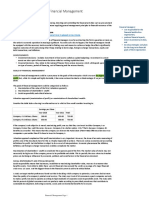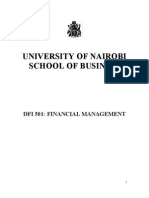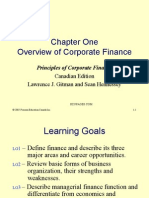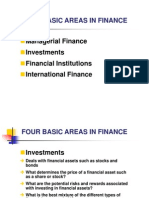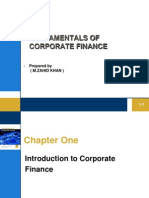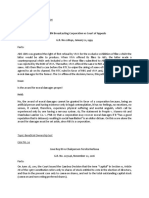The Role of Managerial Finance
The Role of Managerial Finance
Uploaded by
mild incCopyright:
Available Formats
The Role of Managerial Finance
The Role of Managerial Finance
Uploaded by
mild incOriginal Title
Copyright
Available Formats
Share this document
Did you find this document useful?
Is this content inappropriate?
Copyright:
Available Formats
The Role of Managerial Finance
The Role of Managerial Finance
Uploaded by
mild incCopyright:
Available Formats
Copyright 2012 Pearson Education.
Chapter 1
The Role of
Managerial
Finance
2012 Pearson Education 1-2
Learning Goals
LG1 Define finance and the managerial finance function.
LG2 Describe the legal forms of business organization.
LG3 Describe the goal of the firm, and explain why
maximizing the value of the firm is an appropriate
goal for a business.
2012 Pearson Education 1-3
Learning Goals (cont.)
LG4 Describe how the managerial finance function is
related to economics and accounting.
LG5 Identify the primary activities of the financial
manager.
LG6 Describe the nature of the principle-agent relationship
between the owners and managers of a corporation,
and explain how various corporate governance
mechanisms attempt to manage agency problems.
2012 Pearson Education 1-4
What is Finance?
Finance can be defined as the science and art of managing
money.
At the personal level, finance is concerned with
individuals decisions about how much of their earnings
they spend, how much they save, and how they invest
their savings.
In a business context, finance involves the same types of
decisions: how firms raise money from investors, how
firms invest money in an attempt to earn a profit, and how
they decide whether to reinvest profits in the business or
distribute them back to investors.
2012 Pearson Education 1-5
Career Opportunities in
Finance: Financial Services
Financial Services is the area of finance concerned with
the design and delivery of advice and financial products
to individuals, businesses, and governments.
Career opportunities include banking, personal financial
planning, investments, real estate, and insurance.
2012 Pearson Education 1-6
Career Opportunities in
Finance: Managerial Finance
Managerial finance is concerned with the duties of the
financial manager working in a business.
Financial managers administer the financial affairs of all
types of businessesprivate and public, large and small,
profit-seeking and not-for-profit.
They perform such varied tasks as developing a financial
plan or budget, extending credit to customers, evaluating
proposed large expenditures, and raising money to fund
the firms operations.
2012 Pearson Education 1-7
Career Opportunities in Finance:
Managerial Finance (cont.)
The recent global financial crisis and subsequent
responses by governmental regulators, increased global
competition, and rapid technological change also increase
the importance and complexity of the financial managers
duties.
Increasing globalization has increased demand for
financial experts who can manage cash flows in different
currencies and protect against the risks that naturally arise
from international transactions.
2012 Pearson Education 1-8
Focus on Practice
Professional Certifications in Finance:
Chartered Financial Analyst (CFA) Offered by the CFA
Institute, the CFA program is a graduate-level course of study
focused primarily on the investments side of finance.
Certified Treasury Professional (CTP) The CTP program
requires students to pass a single exam that is focused on the
knowledge and skills needed for those working in a corporate
treasury department.
Certified Financial Planner (CFP) To obtain CFP status,
students must pass a ten-hour exam covering a wide range of
topics related to personal financial planning.
2012 Pearson Education 1-9
Focus on Practice (cont.)
Professional Certifications in Finance:
American Academy of Financial Management (AAFM) The
AAFM administers a host of certification programs for financial
professionals in a wide range of fields. Their certifications
include the Charter Portfolio Manager, Chartered Asset
Manager, Certified Risk Analyst, Certified Cost Accountant,
Certified Credit Analyst, and many other programs.
Professional Certifications in Accounting Most professionals
in the field of managerial finance need to know a great deal
about accounting to succeed in their jobs. Professional
certifications in accounting include the Certified Public
Accountant (CPA), Certified Management Accountant (CMA),
Certified Internal Auditor (CIA), and many programs.
2012 Pearson Education 1-10
Legal Forms of Business
Organization
A sole proprietorship is a business owned by one person
and operated for his or her own profit.
A partnership is a business owned by two or more
people and operated for profit.
A corporation is an entity created by law. Corporations
have the legal powers of an individual in that it can sue
and be sued, make and be party to contracts, and acquire
property in its own name.
2012 Pearson Education 1-11
Table 1.1 Strengths and Weaknesses of the
Common Legal Forms of Business Organization
2012 Pearson Education 1-12
Matter of Fact
2012 Pearson Education 1-13
Figure 1.1 Corporate
Organization
2012 Pearson Education 1-14
Table 1.2 Career Opportunities
in Managerial Finance
2012 Pearson Education 1-15
Goal of the Firm:
Maximize Shareholder Wealth
Decision rule for managers: only take actions that are
expected to increase the share price.
2012 Pearson Education 1-16
Goal of the Firm:
Maximize Profit?
Profit maximization may not lead to the highest possible share price
for at least three reasons:
1. Timing is importantthe receipt of funds sooner rather than later is preferred
2. Profits do not necessarily result in cash flows available to stockholders
3. Profit maximization fails to account for risk
Which Investment is Preferred?
2012 Pearson Education 1-17
Goal of the Firm:
What About Stakeholders?
Stakeholders are groups such as employees, customers,
suppliers, creditors, owners, and others who have a direct
economic link to the firm.
A firm with a stakeholder focus consciously avoids
actions that would prove detrimental to stakeholders. The
goal is not to maximize stakeholder well-being but to
preserve it.
Such a view is considered to be "socially responsible."
2012 Pearson Education 1-18
The Role of Business Ethics
Business ethics are the standards of conduct or moral
judgment that apply to persons engaged in commerce.
Violations of these standards in finance involve a variety
of actions: creative accounting, earnings management,
misleading financial forecasts, insider trading, fraud,
excessive executive compensation, options backdating,
bribery, and kickbacks.
Negative publicity often leads to negative impacts on a
firm
2012 Pearson Education 1-19
The Role of Business Ethics:
Considering Ethics
Robert A. Cooke, a noted ethicist, suggests that the
following questions be used to assess the ethical viability of
a proposed action:
Is the action arbitrary or capricious? Does the action unfairly
single out an individual or group?
Does the action affect the morals, or legal rights of any
individual or group?
Does the action conform to accepted moral standards?
Are there alternative courses of action that are less likely to
cause actual or potential harm?
2012 Pearson Education 1-20
The Role of Business Ethics:
Ethics and Share Price
Ethics programs seek to:
reduce litigation and judgment costs
maintain a positive corporate image
build shareholder confidence
gain the loyalty and respect of all stakeholders
The expected result of such programs is to positively affect
the firms share price.
2012 Pearson Education 1-21
Focus on Ethics
Will Google Live Up to Its Motto?
In January 2010, Google announced that the Gmail accounts of
Chinese human-rights activists and a number of technology,
financial, and defense companies had been hacked.
The company threatened to pull out of China unless an
agreement on uncensored search results could be reached.
Is the goal of maximization of shareholder wealth necessarily
ethical or unethical?
How can Google justify its actions in the short run to its long
run investors?
2012 Pearson Education 1-22
Managerial Finance Function
The size and importance of the managerial finance
function depends on the size of the firm.
In small firms, the finance function is generally
performed by the accounting department.
As a firm grows, the finance function typically evolves
into a separate department linked directly to the company
president or CEO through the chief financial officer
(CFO) (see Figure 1.1)
2012 Pearson Education 1-23
Managerial Finance Function:
Relationship to Economics
The field of finance is closely related to economics.
Financial managers must understand the economic
framework and be alert to the consequences of varying
levels of economic activity and changes in economic
policy.
They must also be able to use economic theories as
guidelines for efficient business operation.
2012 Pearson Education 1-24
Managerial Finance Function:
Relationship to Economics (cont.)
Marginal costbenefit analysis is the economic principle
that states that financial decisions should be made and
actions taken only when the added benefits exceed the
added costs
Marginal cost-benefit analysis can be illustrated using the
following simple example.
2012 Pearson Education 1-25
Managerial Finance Function:
Relationship to Economics (cont.)
Nord Department Stores is applying marginal-cost benefit
analysis to decide whether to replace a computer:
2012 Pearson Education 1-26
Managerial Finance Function:
Relationship to Accounting
The firms finance and accounting activities are closely-
related and generally overlap.
In small firms accountants often carry out the finance
function, and in large firms financial analysts often help
compile accounting information.
One major difference in perspective and emphasis
between finance and accounting is that accountants
generally use the accrual method while in finance, the
focus is on cash flows.
2012 Pearson Education 1-27
Managerial Finance Function:
Relationship to Accounting (cont.)
Whether a firm earns a profit or experiences a loss, it must
have a sufficient flow of cash to meet its obligations as
they come due.
The significance of this difference can be illustrated using
the following simple example.
2012 Pearson Education 1-28
Managerial Finance Function:
Relationship to Accounting (cont.)
The Nassau Corporation experienced the following activity
last year:
Sales $100,000 (1 yacht sold, 100% still uncollected)
Costs $ 80,000 (all paid in full under supplier terms)
2012 Pearson Education 1-29
Managerial Finance Function:
Relationship to Accounting (cont.)
Now contrast the differences in performance under the
accounting method (accrual basis) versus the financial view
(cash basis):
Income Statement Summary
Accrual basis Cash basis
Sales $100,000 $ 0
Less: Costs (80,000) (80,000)
Net Profit/(Loss) $ 20,000 $(80,000)
2012 Pearson Education 1-30
Managerial Finance Function:
Relationship to Accounting (cont.)
Finance and accounting also differ with respect to decision-
making:
Accountants devote most of their attention to the collection and
presentation of financial data.
Financial managers evaluate the accounting statements, develop
additional data, and make decisions on the basis of their
assessment of the associated returns and risks.
2012 Pearson Education 1-31
Personal Finance Example
2012 Pearson Education 1-32
Figure 1.3
Financial Activities
2012 Pearson Education 1-33
Governance and Agency:
Corporate Governance
Corporate governance refers to the rules, processes, and
laws by which companies are operated, controlled, and
regulated.
It defines the rights and responsibilities of the corporate
participants such as the shareholders, board of directors,
officers and managers, and other stakeholders, as well as
the rules and procedures for making corporate decisions.
The structure of corporate governance was previously
described in Figure 1.1.
2012 Pearson Education 1-34
Governance and Agency:
Individual versus Institutional Investors
Individual investors are investors who own relatively small
quantities of shares so as to meet personal investment goals.
Institutional investors are investment professionals, such as banks,
insurance companies, mutual funds, and pension funds, that are paid
to manage and hold large quantities of securities on behalf of others.
Unlike individual investors, institutional investors often monitor and
directly influence a firms corporate governance by exerting pressure
on management to perform or communicating their concerns to the
firms board.
2012 Pearson Education 1-35
Governance and Agency:
Government Regulation
Government regulation generally shapes the corporate
governance of all firms.
During the recent decade, corporate governance has
received increased attention due to several high-profile
corporate scandals involving abuse of corporate power
and, in some cases, alleged criminal activity by corporate
officers.
2012 Pearson Education 1-36
Governance and Agency:
Government Regulation
The Sarbanes-Oxley Act of 2002:
established an oversight board to monitor the accounting industry;
tightened audit regulations and controls;
toughened penalties against executives who commit corporate fraud;
strengthened accounting disclosure requirements and ethical guidelines for
corporate officers;
established corporate board structure and membership guidelines;
established guidelines with regard to analyst conflicts of interest;
mandated instant disclosure of stock sales by corporate executives;
increased securities regulation authority and budgets for auditors and investigators.
2012 Pearson Education 1-37
Governance and Agency:
The Agency Issue
A principal-agent relationship is an arrangement in
which an agent acts on the behalf of a principal. For
example, shareholders of a company (principals) elect
management (agents) to act on their behalf.
Agency problems arise when managers place personal
goals ahead of the goals of shareholders.
Agency costs arise from agency problems that are borne
by shareholders and represent a loss of shareholder
wealth.
2012 Pearson Education 1-38
The Agency Issue:
Management Compensation Plans
In addition to the roles played by corporate boards,
institutional investors, and government regulations,
corporate governance can be strengthened by ensuring
that managers interests are aligned with those of
shareholders.
A common approach is to structure management
compensation to correspond with firm performance.
2012 Pearson Education 1-39
The Agency Issue:
Management Compensation Plans
Incentive plans are management compensation plans that
tie management compensation to share price; one example
involves the granting of stock options.
Performance plans tie management compensation to
measures such as EPS or growth in EPS. Performance
shares and/or cash bonuses are used as compensation
under these plans.
2012 Pearson Education 1-40
Matter of FactForbes.com
CEO Performance vs. Pay
2012 Pearson Education 1-41
The Agency Issue: The Threat
of Takeover
When a firms internal corporate governance structure is
unable to keep agency problems in check, it is likely that
rival managers will try to gain control of the firm.
The threat of takeover by another firm, which believes it
can enhance the troubled firms value by restructuring its
management, operations, and financing, can provide a
strong source of external corporate governance.
2012 Pearson Education 1-42
Thank you
You might also like
- Chapter 1 - Overview of Financial ManagementDocument4 pagesChapter 1 - Overview of Financial Management132345usdfghjNo ratings yet
- Consolidated FM NotesDocument227 pagesConsolidated FM NotesTitus GachuhiNo ratings yet
- Chapter 1-The Role of Managerial FinanceDocument45 pagesChapter 1-The Role of Managerial FinanceDewi khornida marheniNo ratings yet
- 1-The Role of Managerial FinanceDocument34 pages1-The Role of Managerial FinanceRaneem AlNo ratings yet
- CHAPTER 1 Intro To FinanceDocument38 pagesCHAPTER 1 Intro To FinanceHazlina HusseinNo ratings yet
- Financial ch1pdfDocument42 pagesFinancial ch1pdfx72bgysvcwNo ratings yet
- The Role of Managerial FinanceDocument44 pagesThe Role of Managerial Financelouise carinoNo ratings yet
- The Role of Managerial Finance: All Rights ReservedDocument45 pagesThe Role of Managerial Finance: All Rights ReservedmoonaafreenNo ratings yet
- The Role of Managerial Finance: All Rights ReservedDocument58 pagesThe Role of Managerial Finance: All Rights ReservedTextro VertNo ratings yet
- Topic1gitman pmf13 ppt01Document31 pagesTopic1gitman pmf13 ppt01zack farisNo ratings yet
- The Role of Managerial Finance: All Rights ReservedDocument53 pagesThe Role of Managerial Finance: All Rights Reservedibrahim alamirNo ratings yet
- The Role of Managerial FinanceDocument37 pagesThe Role of Managerial Financelayan123456No ratings yet
- Gitman Pmf13 Ppt01pinar 2Document36 pagesGitman Pmf13 Ppt01pinar 2Sinem Dilara HaşimoğluNo ratings yet
- Chapter 1 Financial Markets - SecuritiesDocument43 pagesChapter 1 Financial Markets - SecuritiesRomario KhaledNo ratings yet
- The Role of Managerial FinanceDocument44 pagesThe Role of Managerial FinanceRa'fat JalladNo ratings yet
- The Role of Managerial FinanceDocument46 pagesThe Role of Managerial FinancedhfbbbbbbbbbbbbbbbbbhNo ratings yet
- The Role of Managerial Finance: All Rights ReservedDocument39 pagesThe Role of Managerial Finance: All Rights ReservedJesterdanceNo ratings yet
- The Role of Managerial FinanceDocument40 pagesThe Role of Managerial FinanceJackBelmandoNo ratings yet
- CH 1 Role of Managerial FinanceDocument38 pagesCH 1 Role of Managerial FinanceAkash KarNo ratings yet
- 1the Role of Managerial FinanceDocument28 pages1the Role of Managerial Financeswap99482No ratings yet
- Section 1-CH.1Document36 pagesSection 1-CH.1mtfm2004No ratings yet
- FIN Chapter 1Document22 pagesFIN Chapter 1tarek khanNo ratings yet
- The Role of Managerial FinanceDocument37 pagesThe Role of Managerial FinanceMalak W.No ratings yet
- Managerial Finance Chapter 1 (An Overview)Document23 pagesManagerial Finance Chapter 1 (An Overview)Opie Om100% (1)
- What Is FinanceDocument22 pagesWhat Is FinanceChantalNo ratings yet
- Chapter 1 BookDocument32 pagesChapter 1 Bookim ahmedNo ratings yet
- Introduction To Financial ManagementDocument82 pagesIntroduction To Financial ManagementJohn Joseph CambaNo ratings yet
- The Role of Managerial Finance: All Rights ReservedDocument22 pagesThe Role of Managerial Finance: All Rights Reservedحمزہ قاسم کاھلوں جٹNo ratings yet
- The Role of Managerial Finance: All Rights ReservedDocument45 pagesThe Role of Managerial Finance: All Rights ReservedRemi SabirNo ratings yet
- Financial-Management - Lesson 1-What Is FinanceDocument10 pagesFinancial-Management - Lesson 1-What Is FinanceMargie RosetNo ratings yet
- The Role of Managerial FinanceDocument37 pagesThe Role of Managerial FinanceZidan ZaifNo ratings yet
- The Role of Managerial FinanceDocument49 pagesThe Role of Managerial FinanceSehel SomaniNo ratings yet
- EM270 Ch01 - UpdatedDocument8 pagesEM270 Ch01 - UpdatedtrabajoslaprensaNo ratings yet
- Rangkuman Buat UTSDocument8 pagesRangkuman Buat UTSanggiNo ratings yet
- Rangkuman Buat UTSDocument8 pagesRangkuman Buat UTSanggiNo ratings yet
- Chapter One Overview of Managerial FinanceDocument29 pagesChapter One Overview of Managerial Finance9605No ratings yet
- Chapter 1 Part 1Document9 pagesChapter 1 Part 1Mo'men ElboklNo ratings yet
- Lecture - 01 - Role of Financial ManagementDocument41 pagesLecture - 01 - Role of Financial ManagementRajit DhillonNo ratings yet
- Fin 254 CH 1 AsyDocument45 pagesFin 254 CH 1 AsyCrap WeaselNo ratings yet
- M01 Gitman50803X 14 MF C01Document52 pagesM01 Gitman50803X 14 MF C01RaniaNo ratings yet
- The Role of Managerial FinanceDocument34 pagesThe Role of Managerial FinanceSajjad RavinNo ratings yet
- FIN Chapter 1-1Document16 pagesFIN Chapter 1-1Shadman ShantoNo ratings yet
- FIN 254 - Chapter 1Document23 pagesFIN 254 - Chapter 1habibNo ratings yet
- 01 Zutter Smart PMF 16e Accessible LGSDocument69 pages01 Zutter Smart PMF 16e Accessible LGStl4178No ratings yet
- Chapter 1 Part 2Document10 pagesChapter 1 Part 2Mo'men ElboklNo ratings yet
- FINMANDocument10 pagesFINMANMine MineNo ratings yet
- Ch1 Financial Management Lawrence J GitmanDocument29 pagesCh1 Financial Management Lawrence J GitmanGözde Çetinkol100% (1)
- FinanceDocument28 pagesFinancetashfik120No ratings yet
- 1Document13 pages1gamalbedNo ratings yet
- Financial Management - Chapter 01Document26 pagesFinancial Management - Chapter 01Joe HizulNo ratings yet
- SM ch1Document18 pagesSM ch1Arie WidodoNo ratings yet
- Financial Management Chapter 1Document47 pagesFinancial Management Chapter 1nida.rasheed355No ratings yet
- LN01Brooks671956 02 LN01Document22 pagesLN01Brooks671956 02 LN01nightdazeNo ratings yet
- CH 1 f3716sDocument20 pagesCH 1 f3716salbabtainbaderNo ratings yet
- Fundamentals of Corporate Finance: Prepared by (M.Zahid Khan)Document34 pagesFundamentals of Corporate Finance: Prepared by (M.Zahid Khan)Syed Maaz HasanNo ratings yet
- Introduction To Corporate Finance: Mcgraw-Hill/IrwinDocument30 pagesIntroduction To Corporate Finance: Mcgraw-Hill/IrwinDaireen ShahrinNo ratings yet
- The Role of Financial ManagementDocument30 pagesThe Role of Financial ManagementNoor DeenNo ratings yet
- Business Finance ABM StrandDocument107 pagesBusiness Finance ABM StrandMiss Anonymous23No ratings yet
- Financial Literacy for Entrepreneurs: Understanding the Numbers Behind Your BusinessFrom EverandFinancial Literacy for Entrepreneurs: Understanding the Numbers Behind Your BusinessNo ratings yet
- Financial Accounting StandardsDocument2 pagesFinancial Accounting StandardsGauravNo ratings yet
- X90zygofhx PDFDocument1 pageX90zygofhx PDFYoutuber GamerNo ratings yet
- Mortgage SampleDocument10 pagesMortgage SampleIlankumaran kNo ratings yet
- Draft Conference 2024 Write Up & ProgrammeDocument4 pagesDraft Conference 2024 Write Up & ProgrammeShamil FitriNo ratings yet
- Principles of Accounting Chapter 11Document41 pagesPrinciples of Accounting Chapter 11myrentistoodamnhigh100% (1)
- Resume June 2021Document1 pageResume June 2021api-554662620No ratings yet
- DLMI-CG ReportDocument40 pagesDLMI-CG ReportArteezyNo ratings yet
- 46037d1c-c05a-409e-9426-53603f85c82cDocument1 page46037d1c-c05a-409e-9426-53603f85c82cIshanku BorahNo ratings yet
- 3492 - KFC - AnnualReport - 2004-12-31 - KFC-AnnualReport2004 (1.3MB) - 1410789201 PDFDocument168 pages3492 - KFC - AnnualReport - 2004-12-31 - KFC-AnnualReport2004 (1.3MB) - 1410789201 PDFSuresh MuruganNo ratings yet
- Company Law Notes - FinalDocument219 pagesCompany Law Notes - FinalAwonke Goso100% (1)
- Guide For Establishing A Company in Serbia: Legal Framework - Sectoral Licenses - ProcedureDocument48 pagesGuide For Establishing A Company in Serbia: Legal Framework - Sectoral Licenses - ProcedureRadivojJovanovNo ratings yet
- Mahapatra ResignationDocument3 pagesMahapatra Resignationkaran.ozaNo ratings yet
- Regulatory Framework For Business Transactions: PartnershipDocument7 pagesRegulatory Framework For Business Transactions: PartnershipKatharsisNo ratings yet
- In Note L To Its 2004 Financial Statements Ibm IncludesDocument1 pageIn Note L To Its 2004 Financial Statements Ibm IncludesM Bilal SaleemNo ratings yet
- CORPORATION REVIEWER VillanuevaDocument142 pagesCORPORATION REVIEWER Villanuevabobbys88No ratings yet
- Financial Derivatives Assignment 2Document1 pageFinancial Derivatives Assignment 2muskan sharmaNo ratings yet
- DLF Limited (Delhi Land & Finance) Is Based Developer. It Was Founded by Chaudhary Raghvendra Singh in 1946 and Is Based inDocument5 pagesDLF Limited (Delhi Land & Finance) Is Based Developer. It Was Founded by Chaudhary Raghvendra Singh in 1946 and Is Based inAbhishek RajputNo ratings yet
- PFRS 11 Joint ArrangementsDocument2 pagesPFRS 11 Joint ArrangementsElla MaeNo ratings yet
- 5 Corpo Number 5Document32 pages5 Corpo Number 5Miko TabandaNo ratings yet
- Company Law NotesDocument28 pagesCompany Law NotesDickson Tk Chuma Jr.No ratings yet
- Top 25 Problems On Dissolution of A Partnership Firm PDFDocument1 pageTop 25 Problems On Dissolution of A Partnership Firm PDFDaniza Rose AltoNo ratings yet
- Shares Suspended For TradingDocument1 pageShares Suspended For TradingPushparaj ThangarajNo ratings yet
- Law 106 Corporation LawDocument9 pagesLaw 106 Corporation LawMitchi BarrancoNo ratings yet
- INGA Annual ReportDocument115 pagesINGA Annual ReportNasaribNo ratings yet
- Corporations OutlineDocument49 pagesCorporations OutlineAnonymous gRxpsMVNo ratings yet
- LEXINGTONREALTY10KDocument196 pagesLEXINGTONREALTY10Kmatthewphenry1951No ratings yet
- Anti-Takeover Measure: Measures Protect A Company's Autonomy and Market CompetitivenessDocument4 pagesAnti-Takeover Measure: Measures Protect A Company's Autonomy and Market CompetitivenessKurt CaneroNo ratings yet
- 1 Life Insurance Companies Operating in IndiaDocument1 page1 Life Insurance Companies Operating in Indiayashika goyal DNo ratings yet
- 2019 PDFDocument166 pages2019 PDFRosenna99No ratings yet
